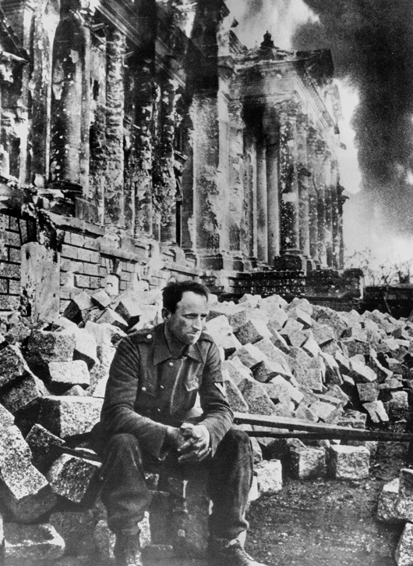On 12 April 1945 the Berlin Philharmonic gave its last performance. The atmosphere in Germany was apocalyptic, the Allied invasion was expected at any moment. The concert playlist had been devised by Hitler’s architect, Albert Speer, and included Brünnhilde’s last aria and the finale from Wagner’s Götterdämmerung, the ‘twilight of the gods’. There were reports that members of the Hitler Youth offered the audience cyanide capsules at the end.
Such was the grotesque theatre of the Nazi death cult; Speer was chief set-designer for the Reich, devising the Nuremberg Parade Grounds and the megalomaniacal concept of ‘Ruinenwert’ (‘ruin value,’ or buildings that decayed ‘well’.) These schemes were now inflected with macabre irony, as Hitler planned his own Führer-dämmerung. ‘Evil be on earth,’ goes the Icelandic Edda Völuspá, describing the twilight of the gods as ‘a wind-age, a wolf-age/ no man to another shall mercy show.’ The earth sinks into the sea, the sun turns black, the sky is scorched with fire.
A few days before the Berlin concert, Goebbels argued, preposterously, for the redemptive effects of the Nazi apocalypse: ‘We are bearing a heavy fate because we are fighting for a good cause, and are called bravely to endure the battle to achieve greatness.’ Within weeks, Hitler was dead. German cities lay in ruins, their inhabitants, as Stephen Spender wrote, reduced to the status of ‘parasites sucking at a dead carcass’. The world lay in ruins, and perhaps as many as 85 million people had lost their lives. Then there were the wounded, those who had endured rape and torture, the displaced, refugees moving through annihilated lands, many of them with little chance of survival.
What was it like to be there, when the world was destroyed and unfathomable numbers were dead, or ‘starving, or bent on bloody revenge’? This is the central concern of Ian Buruma’s latest book, Year Zero: A History of 1945.







Comments
Join the debate for just £1 a month
Be part of the conversation with other Spectator readers by getting your first three months for £3.
UNLOCK ACCESS Just £1 a monthAlready a subscriber? Log in